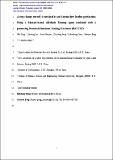Por favor, use este identificador para citar o enlazar a este item:
http://hdl.handle.net/10261/257578COMPARTIR / EXPORTAR:
 SHARE SHARE
 CORE
BASE CORE
BASE
|
|
| Visualizar otros formatos: MARC | Dublin Core | RDF | ORE | MODS | METS | DIDL | DATACITE | |

| Título: | A step-change toward a sustainable and chrome-free leather production: Using a biomass-based, aldehyde tanning agent combined with a pioneering terminal aluminum tanning treatment (BAT-TAT) |
Autor: | Ding, Wei; Liu, Haiteng; Remón, Javier CSIC ORCID; Jiang, Zhicheng; Cheng, Guodong; Pang, Xiaoyan; Ding, Zhiwen | Palabras clave: | Biomass-based aldehyde Chrome-free leather Eco-friendly technology Terminal aluminum tanning treatment Physical properties |
Fecha de publicación: | 21-dic-2021 | Editor: | Elsevier | Citación: | Journal of Cleaner Production 333: 130201 (2022) | Resumen: | The traditional chrome-based leather industry is facing several restrictions due to potential risks to the environment, especially for the formation and release of hazardous and carcinogenic Cr (VI). However, the leather produced from alternative organic tanning agents generally does not meet the market requirements due to the poor fixation of some of the conventional anionic post-tanning materials. Herein, we report on a pioneering, Cr-free strategy to produce high-quality leather. It comprises the use of a carbon-neutral, biomass-based aldehyde (BAT) tanning agent, efficiently fixed in the leather by means of novel terminal aluminum tanning treatment (TAT). In this treatment, Al (III) bonded with the excess oxygen-containing functional groups present in the BAT, post-tanning materials and collagen fibers. As a result, these connections created a robust crosslinking network, leading to leather products with similar (and in some cases superior) properties to those produced with the conventional Cr tanning procedure. For example, the tensile and tear strengths (19.78 N/mm2, 101.47 N/mm) were much higher than those of the Cr leather (7.13 N/mm2 and 43.12 N/mm). Therefore, these outstanding results, along with the carbon-neutral and environmentally-friendly features of our BAT-TAT strategy, are a step-change toward chrome-free leather production, which paves the way to ensuring the viable and sustainable development of the leather industry. | Descripción: | 8 figures, 3 tables.-- © 2021. This manuscript version is made available under the CC-BY-NC-ND 4.0 license https://creativecommons.org/licenses/by-nc-nd/4.0/ | Versión del editor: | http://dx.doi.org/10.1016/j.jclepro.2021.130201 | URI: | http://hdl.handle.net/10261/257578 | DOI: | 10.1016/j.jclepro.2021.130201 | ISSN: | 0959-6526 |
| Aparece en las colecciones: | (ICB) Artículos |
Ficheros en este ítem:
| Fichero | Descripción | Tamaño | Formato | |
|---|---|---|---|---|
| j.jclepro.2021.130201.pdf | Artículo principal | 1,6 MB | Adobe PDF |  Visualizar/Abrir |
| 1-s2.0-S0959652621043663-mmc1.docx | Información suplementaria | 171,14 kB | Microsoft Word XML | Visualizar/Abrir |
CORE Recommender
SCOPUSTM
Citations
26
checked on 06-may-2024
WEB OF SCIENCETM
Citations
18
checked on 24-feb-2024
Page view(s)
73
checked on 21-may-2024
Download(s)
23
checked on 21-may-2024
Google ScholarTM
Check
Altmetric
Altmetric
Este item está licenciado bajo una Licencia Creative Commons



